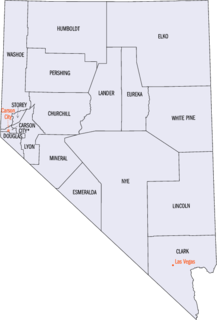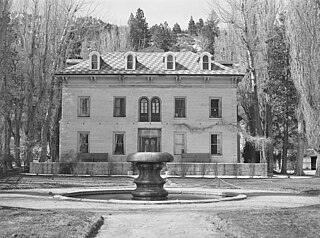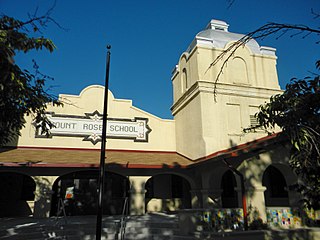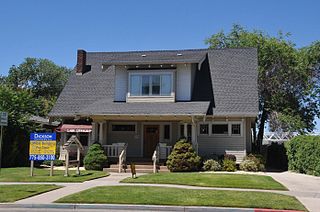
Sparks is a city in Washoe County, Nevada, United States. It was founded in 1904, incorporated on March 15, 1905, and is located just east of Reno. The 2019 U.S. Census Bureau American Community Survey population count was 105,006. It is the fifth most populous city in Nevada. It is named after the late Nevada Governor John Sparks, a member of the Silver Party.

Gerlach, Nevada is a census-designated place (CDP) in Washoe County, Nevada, United States. The population was 107 at the 2018 American Community Survey. It is part of the Reno–Sparks Metropolitan Statistical Area. Prior to 2010, Gerlach was part of the Gerlach–Empire census-designated place. The town of Empire is now a separate CDP. The next nearest town, Nixon, is 60 miles (100 km) to the south on a reservation owned by the Pyramid Lake Paiute Tribe. The Fly Geyser is located near Gerlach.
Frederic Joseph DeLongchamps was an American architect. He was one of Nevada's most prolific architects, yet is notable for entering the architectural profession with no extensive formal training. He has also been known as Frederick J. DeLongchamps, and was described by the latter name in an extensive review of the historic importance of his works which led to many of them being listed on the U.S. National Register of Historic Places in the 1980s.

This is a list of properties and historic districts in Nevada that are listed on the National Register of Historic Places. There is at least one listing in each of Nevada's 16 counties and one independent city.

The Bowers Mansion, located between Reno and Carson City, Nevada, was built in 1863 by Lemuel "Sandy" Bowers and his wife, Eilley Orrum Bowers, and is a prime example of the homes built in Nevada by the new millionaires of the Comstock Lode mining boom.

The Twaddle-Pedroli Ranch, also known as the Jackson-Harp Ranch, Rand Property and the Wilson Commons Ranch, was purchased by John Twaddle in 1869 for $5,000. The ranch, several miles to the north of Franktown, Nevada and adjacent to the Bowers Mansion, was then known as the Sturtevant Ranch. The property amounted to 630 acres (250 ha).

The Field Matron's Cottage, also known as the Stone Building, was built circa 1925 on the Reno-Sparks Indian Colony in Sparks, Nevada. The cottage was built to support a Bureau of Indian Affairs program to instruct the 20 acres (8.1 ha) colony's Paiute and Washoe girls in sanitation and housekeeping skills. A "field matron" was provided by the Bureau from 1919 to as late as 1938. At first the matron lived in Reno, at some distance from the colony, but in 1926 funding was made available to build a dwelling on colony lands, allowing a closer relationship between the matron and the colony's inhabitants. The cottage included a library and an infirmary, and served as a community meeting place.

The Virginia Street Bridge was a historic concrete double arch bridge in downtown Reno, Nevada, US, carrying Virginia Street across the Truckee River. It was added to the National Register of Historic Places in 1980. The bridge is sometimes referred to as the "Wedding Ring Bridge" or the "Bridge of Sighs".

The Walter Cliff Ranch District, at 7635 Old HW 395 in Washoe Valley, Nevada is a historic site that was listed as a historic district on the National Register of Historic Places in 1985. It has significance dating from c.1870, when the house was built. The listing included two contributing buildings: the house and a root cellar/residence building.

The Washoe County Courthouse, at 117 S. Virginia St. in Reno, Nevada, was built in 1910. It is significant for playing a role in the divorce industry in Nevada during the first half of the 20th century, when divorce was legal in Nevada and liberal residency requirements were enacted, while divorce was much more difficult elsewhere. In 1931, more than 4,800 divorces were processed in northern Nevada, most processed through this courthouse; it was economically important, with $5,000,000 being spent per year in Reno by divorcing parties.

Mount Rose K-8 School of Languages, formerly Mount Rose Elementary School, is a public K-8 school at 915 Lander St. in Reno, Nevada, operated by the Washoe County School District. It occupies a historic Mission/Spanish Revival-style facility that was built in 1912 and extended in 1938. It was listed on the National Register of Historic Places in 1977 under the name Mount Rose Elementary.

The Veterans Memorial Elementary School, also known as Veterans Memorial STEM Academy, at 1200 Locust St., is a public elementary school in Reno, Nevada, operated by the Washoe County School District. It occupies a historic Moderne-style building dating from 1949 that was designed by Nevada architect Russell Mills. It was listed on the National Register of Historic Places in 1995. It was deemed significant "for its role in the local history of education" and "for its Art Deco/Moderne style of architecture by a prominent local architect, Russell Mills."

Immaculate Conception Catholic Church, is currently located at 2900 McCarran Way in Sparks, Nevada, United States. It is part of the Roman Catholic Diocese of Reno.

The Pincolini Hotel, at 214 Lake St. in Reno, Nevada was a historic hotel that was built in 1922 and expanded in 1925 and 1930. Also known as the Mizpah Hotel, it was listed on the National Register of Historic Places in 1984.

The Lake Mansion in Reno, Nevada, is a historic house that originally stood at the corner of Virginia and California Streets and is now located at 250 Court Street. It was built in 1877 by W.J. Marsh. It includes Late Victorian and Italianate architecture and was a home associated with Myron Lake, one of Reno's founders, who bought it in 1879.

The Downtown Reno Library is the main library of the Washoe County Library System, at 301 S. Center St. in Reno, Nevada. It occupies a historic Modern-style building listed on the National Register of Historic Places as the Washoe County Library. It is known also as the Downtown Library. It was designed by Hewitt Campau Wells in Modern style and was built in 1965.

The Benson Dillon Billinghurst House, at 729 Evans Ave. in Reno, Nevada, was built in 1910. It was a home of educator Benson Dillon Billinghurst, who was superintendent of schools of Washoe County during a long period, from 1908 until his death in 1935. He led innovations such as the introduction of junior high schools. That Nevada's schools were rated second in quality, nationwide, by a 1933 U.S. Department of Education study, was regarded as testament to Billinghurst's leadership statewide. It was listed on the National Register of Historic Places in 1974.
The following is a timeline of the history of the city of Reno, Nevada, United States.
Hewitt C. Wells was an American architect. He designed buildings in San Francisco, California and Nevada, including the National Register of Historic Places-listed Washoe County Library in Reno.
Washoe County Library System is the public library system of Washoe County, Nevada.

















